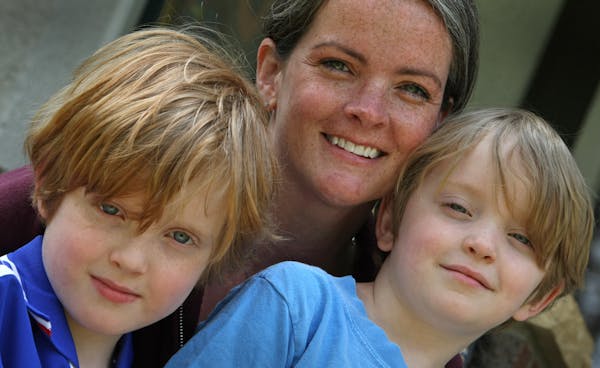There were no leotards or expensive yoga mats in this exercise room -- not even a tidy floor mat to stretch on.
Instead, this group of yoga novices was delving into the soothing art of Yoga Calm in their suit jackets, nylons and name badges in the middle of a Minneapolis school library.
The Minneapolis School District employees were learning how to calm their rambunctious and sometimes challenging students using a rather novel method: yoga.
Their instructors, fellow employees-turned-yoga-gurus, are hoping to change the way schools think about educating their students, one downward-dog stretch at a time.
The instructors, Julie Hurtubise and Kathy Flaminio, have trained more than 500 staff members in 37 Minneapolis schools during their yearlong sabbatical.
Going school to school, the pair instructs fellow district employees on Yoga Calm, an offshoot of traditional yoga that emphasizes the connection between mind and body and focuses primarily on young people.
District employees in turn use the techniques in their classrooms, teaching proper breathing, calming stretches and self-affirmations to their pupils, usually during daily classroom sessions.
Though skeptics may scoff at the approach, Hurtubise and Flaminio say they've seen some pretty amazing results.
Aside being more limber, Flaminio said kids are calmer, more focused and less likely to act aggressively. Teachers are also using yoga to sooth students before tests or counseling sessions, she said.
Yoga "gives them an ability to participate and problem-solve in different ways," Hurtubise said. "It gives them skills and strength and confidence for all students."
And the relaxing exercises don't just apply to learning environments. Students are also using their yoga skills outside the classroom.
"So many kids come from such chaotic places, but we can help them get ready to learn and be part of a classroom," Hurtubise said. "It just develops all sorts of skills."
It's proved helpful for one student whose father died and whose mother is now terminally ill. For others, it provides an outlet for personal frustrations.
"All kinds of kids can find strength in this," Hurtubise said. "They see themselves differently and the world differently."
Focus on stillness, control
The yoga instructors met by chance just last year. Both were interested in taking a year-long, partially paid sabbatical from their district jobs as an occupational therapist and social worker -- both working with special-needs students -- and both loved practicing yoga.
Together, they decided to design a low-cost and relatively simple class curriculum based on Yoga Calm, which was developed in Oregon by a husband-and-wife team of teachers -- Lynea Gillen and Jim Gillen, who provided expert advice and guidance for the program here.
Now, Hurtubise and Flaminio hope their approach can be spread to other school districts around the nation.
Much of the program focuses on the core yoga principles of stillness, listening, grounding, strength and community. No expensive yoga mats or exercising equipment are needed. In an era of annual budget cuts, teachers are finding relief in an effective curriculum that doesn't stretch their already tight budgets.
Desiree Hoggatt, a special education teacher at Lucy Craft Laney Community School, was one of the dozen instructors learning Yoga Calm during a recent Monday program.
Hoggatt, who has taught for 12 years, said she was looking forward to helping her special-needs students learn yoga techniques.
"I'm looking to help relax the kids," she said. "Yoga gives [students with learning disabilities] an outlet for their extra energy."
Though the district seems enthused about the work of Hurtubise and Flaminio, Yoga Calm has sparked some debate as well. Traditional yoga has roots in Eastern religion, causing some community members to question the relationship between religion, public schools and Yoga Calm.
Though Yoga Calm conveys no underlying message of religion, the pair said, a few parents and students have questioned the teaching. The yoga team often invites those with qualms to their instructional meetings so they can observe the curriculum.
With the end of their sabbatical quickly approaching, Hurtubise and Flaminio are trying to figure out their plans, as both seem torn between continuing their yoga work and returning to their school jobs.
"It's been a great year and we've learned a lot, but we feel like it's just started," Hurtubise said. "[Yoga] is really just in little pockets here and there. We'd like to see an overall shift, which isn't easy to create."
At the very least, the pair say they will continue "teaching teachers" Yoga Calm.
"We hope to bring it to all of the district," Flaminio said. "It's the first time in my life where I feel like all of these things are coming together."
Kathryn Nelson is a University of Minnesota student on assignment for the Star Tribune.
Robbinsdale shelter-in-place alert accidentally sent countywide
Developer of St. Paul's Keg & Case food hall declares bankruptcy

Wildlife agency: Sturgeon won't go on endangered species list

Minnesotans interviewed to serve on Feeding Our Future trial

